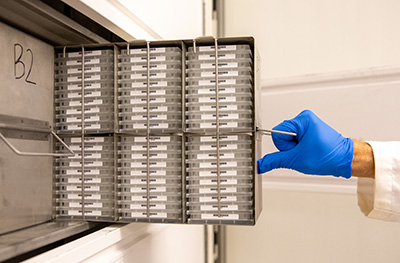Campus News
$2 million grant revamps Chemical Screening Center
A new NIH grant will facilitate more efficient and accessible biomedical research.



A $1.9 million High-End Instrumentation Grant from the National Institutes of Health (NIH) will expedite research at the Chemical Screening Center at UC Santa Cruz.
The high-throughput screening facility helps scientists make discoveries about novel compounds. The center opened in 2007 and still has most of its original equipment. The new grant will pay for state-of-the-art instrumentation and automate more of the process.
“We’ve had a lot of exciting results,” said Scott Lokey, the Chemical Screening Center’s director and a professor of chemistry and biochemistry at UC Santa Cruz. “But then the instrumentation ran its course and aged beyond its useful lifetime.”
At the center, researchers isolate targets—such as a type of cancer cell or bacterium—into tiny individual containers and treat each one with a different compound. They do this with thousands to hundreds-of-thousands of compounds, looking for interesting interactions.
Scientists make note of the compounds that react with the target in a significant way and study them further. Eventually, promising compounds might become new treatments for diseases.
Frozen libraries
UC Santa Cruz houses enormous frozen libraries of compounds. These include a 100,000-member small molecule library provided as part of UCSC’s institutional commitment, a 376,000-member library from the National Cancer Institute’s Program for Natural Product Discovery, an in-house collection of 15,000 natural product extracts, and a library of 2,500 “known bioactives” and FDA-approved drugs.
The two main goals for the new NIH grant are improving instrument reliability and increasing user access and collaborations at the facility.
Currently, researchers work with 384 samples at a time. But they need to screen thousands or more to maximize their chances of finding something useful. With the new liquid handling instrumentation, scientists will be able to screen 1,536 samples at a time, all in a plate around the size of a cell phone.
“We can now screen 100,000 compounds in a day,” said Lokey. “Whereas, it would have taken several weeks to do that with our old instrumentation.”
The new system will also save resources. Previously, scientists had to have more target material than what was technically necessary due to how the liquid handling system collected droplets. A new echo acoustic dispenser will use sound waves to dispense a tiny amount of material—just a few nanoliters, invisible to the naked eye— and only the exact volume needed.
“It’s going to allow our natural products resource to last probably 10 years longer than it would have if we had kept doing it the traditional way,” said John MacMillan, professor of chemistry and biochemistry and associate vice chancellor for research at UCSC.
“To replenish that as a resource is not only very costly, but it’s also very time-intensive,” said MacMillan, who frequently works with bacteria from the ocean.
Several of the researchers who use the facilities face similar challenges. For example, Melissa Jurica, professor of molecular, cell, and developmental biology, studies RNA splicing and screens compounds in nuclear cell extracts.
“It’s really hard to make even a milliliter of nuclear extract,” said Lokey. “Before, it would take her lab many, many weeks to get enough material just to screen a few thousand compounds. But now, in that same period of time, she can screen tens of thousands because of the decreased volume.”
More of the sampling and screening will be robotic, so researchers can program and calibrate the instruments then step back.
“You let it run overnight, and you’ve done 100,000 compounds,” said Lokey.
Screening microscope
The center will also gain a high-content screening microscope. The powerful tool can image live cells in organoids—3-dimensional clusters of cells that function like miniature organs.
This ability will open the door for additional types of research projects, such as efforts led by David Haussler, professor of biomolecular engineering and director of the UCSC Genomics Institute, to understand the human brain using organoids.
The chemical screening center’s new capabilities will likely also increase collaborations across campus and beyond. With less time and material required to screen compounds, more researchers can access the center.
“We have a lot of faculty members who are pushing the limits on understanding biological systems in a way that might lead to novel therapeutic targets,” said MacMillan. “But up until this point in time, very few people on our campus have been able to then take that and make a leap from that basic biological discovery to some sort of a translational benefit. I think the new instrumentation and upgrades to this facility are going to open up a whole new arena for those faculty members.”
The high-throughput screening center could play a particularly important role in finding treatments for tropical and neglected diseases.
“Big drug companies aren’t highly motivated to go after these diseases, because there’s just not a market,” said Lokey. “That’s where academic screening centers can step in.”
That mission fits well with the university’s new global and community health program.
“The Chemical Screening Center is going to be that very critical bridge between understanding the infectious disease and being able to come up with therapies,” said MacMillan. “I think it will be transformational for the campus.”